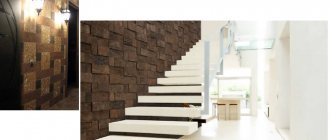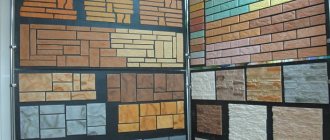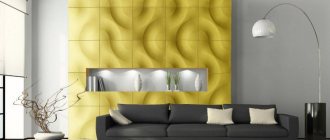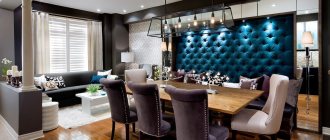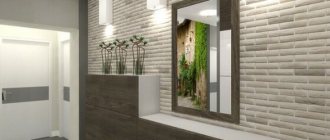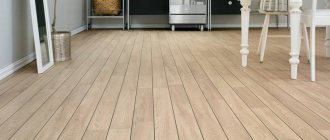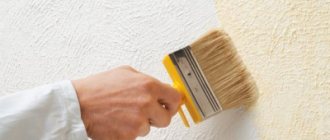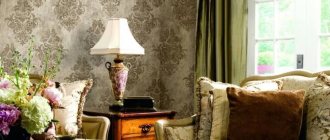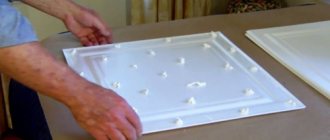Home renovations should not only be of high quality, but also beautiful. They greet you, as they say, by their clothes. Therefore, finishing materials must combine both quality and attractive appearance. Wooden panels for interior wall decoration have these properties. This is a universal option, used both for finishing residential premises and for storage and household premises. They come in different types and have their own positive sides.
Why do we need wooden wall panels?
The use of wood in interior decoration is experiencing a rebirth. Natural building material fits perfectly into a classic interior and is suitable for most modern styles.
Wooden panels are a popular material for interior decoration of the walls of an apartment or house.
Recently, expensive wood has been replaced by decorative panels that imitate natural wood. They give the interior sophistication and special charm. The finish can be used as a panel, as an accent wall, or mounted on a wooden ceiling. In any case, decorative slabs will decorate, give warmth and comfort.
Varieties
Several types of wall panels are used for interior decoration. They may differ not only in shape , but also in the material of manufacture.
It can also be panels made of other materials with wood imitation.
According to their form they can be divided into:
- Tile - rectangular panels (see photo). The length of the sides can vary from 30cm to 100cm. The most common of them are bamboo. Panels with different patterns can be placed in a chaotic manner, ultimately achieving an unusual pattern, which will allow you to create a unique design in the interior.
- Rack - their length can be different. But most often those used are those whose length varies from 2.5 m to 3.7 m. They are used in rooms with a large number of corners, as they are easy to install.
- Leafy - their height can be 2.5 m. Convenient for finishing large areas. Such panels accept painting well, as well as the application of textured materials.
According to the material of manufacture:
- natural wood;
- from MDF;
- from chipboard;
- from fiberboard;
- bamboo;
- glass imitating wood;
- plastic (PVC) wood-look panels.
Facade panels:
- Lining is a facade board intended for finishing walls. It is also made from solid wood. Durable and will last for many years. Easy to install. Good for finishing a country house.
- Imitation timber is an excellent option for a private home or cottage. After complete assembly it creates the effect of respectability. This is a high-quality finishing material, the price of which is very attractive. Practical to use, it is durable.
- Planken - is a facade board with an oblique profile. It harmonizes perfectly with other building materials. Has rounded corners.
- Block house is a finishing board, which is presented in the form of a material that imitates the wall of a log house made of rounded logs. Available in various thicknesses and radii.
- Sandwich panels have a three-layer structure consisting of two sheets of rigid material and a layer of insulation between them. All parts of sandwich panels are glued together using hot or cold pressing.
Do you know which modern materials are best suited for façade cladding? This is covered in this article.
Advantages and disadvantages of wooden wall panels in the interior
Finishing is actively used in residential premises, administrative buildings and offices. The panels decorate the interior and bring benefits due to the following advantages:
- Eco-friendly and hypoallergenic. The material is suitable for children.
- Durability. The panels last for decades. They are easy to repair or partially replace.
- Strength. Thanks to special impregnation, the material does not deform or crack. Not exposed to fungi and insects.
- Easy to care for. It is enough to wipe a wooden wall with a cloth and soapy water.
- Practicality. Sheathing masks uneven walls and communications, such as electrical wiring.
- Soundproofing. The panels prevent sound from spreading. If there is perforation, they create wonderful acoustics.
- Thermal insulation. They cover “cold bridges” and prevent the penetration of drafts.
An additional advantage is ease of installation. The surface of the walls does not require special treatment; the panels are attached easily and quickly.
A wide selection of colors, materials and processing of these panels allows you to bring any design ideas to life and create a unique interior.
Flaws:
- It is better not to use decorative cladding in rooms with high humidity.
- Wooden panels are highly flammable. The solution to the problem is treatment with a special compound.
- The material must be periodically refreshed: varnished or painted.
- The installation frame “eats up” several centimeters of space.
The shortcomings of the material are more than offset by appearance and practicality.
Advantages and disadvantages
Each type of surface repair has both pros and cons. Decorating rooms with wood also has disadvantages and advantages. First you can look at the pros:
- The beauty and overall nobility of the finish cannot be surpassed using other materials.
- This is an almost natural type of design - a few artificial components included in most parts can be ignored.
- Wood has very low thermal conductivity and will provide better heat retention in rooms.
- The situation with extraneous noise will also improve.
- If the wooden parts are properly treated, the cladding will last a long time.
- It’s easy to saw off or cut wood elements, and you only need the simplest tool.
- Installing everything is simple and if you have the basic skills of a repairman, there will be no problems.
- Like other structures attached to the frame, wooden walls will allow you to hide various pipes. Wires or other communications.
- The surface can be painted, varnished or combined with other materials. For example, the combined decoration of walls with wooden panels and fabric looks very beautiful.
Despite all the advantages and disadvantages, wood decoration has very few:
- The moisture resistance of wood is low.
- Even parts treated with fire retardants burn well.
- In any case, repairs will not be cheap.
The existing disadvantages will be completely offset by the advantages of such a solution. In addition, some types of design imply wood in the design, and in this case other materials cannot replace it.
Characteristics of wood wall panels
Is the issue with using wooden slabs resolved? It's time to get acquainted with the features of the material.
By appearance, the panels are divided into:
- sheets;
- slabs (squares);
- slats.
According to the manufacturing method there are:
- From several layers. The outer layer is expensive wood veneer. Inside there are less valuable species.
- From parts of coniferous wood. The product is durable and moisture resistant.
- Made from thin wooden strips glued perpendicular to each other. The output is strong and lightweight sheets.
Wooden panels are quite often used for interior wall decoration.
According to the material of manufacture:
- Made from solid wood. The most expensive and high-quality option. They occupy a leading position in the decoration of offices and libraries.
- Made from chipboards (chipboards) covered with valuable wood veneer or mosaic. In some cases, the slabs are painted. The disadvantage of the material is its heavy weight and low moisture resistance.
- Made from fibreboard (fibreboard). The base of the panels is similar to the previous version, but the board contains wood fibers, which improves the quality.
- Made from medium-density fiberboard, in English it sounds like Medium Density Fiberboard (MDF or MDF). The edge of the planks has a dense structure, the surface is laminated.
- Made from oriented strand board (OSB). Wood chips are used. The disadvantage is the use of formaldehyde resins. Their harm is minimized, but this option is still less environmentally friendly.
Wooden planks differ in the way they decorate the front surface:
- varnished;
- laminated;
- veneered.
In addition, the surface can be matte, glossy or glazed.
Decorating walls with wooden panels in an apartment: masonry options
The finishing material can be fixed to the walls at different angles. It all depends on the chosen design, as well as the priorities of the owner. A decorated room looks individual because there are many options for decorating the interior with wood. The wall will be finished with slats diagonally or vertically, but there will be no repetition, because there are different textured patterns, shades, wood types that have their own shades.
One tree can play with different shades, this depends not only on the processing, but also on the age of the tree.
Herringbone
An interesting way to fix slatted material.
There are 2 types of herringbone installation: fixing the slats at an angle to each other (a herringbone pattern is created on the wall, the branches from below look up, and the length of the “branches” depends on the size of the wall and the room), the second method is to lay the slats one on top of the other horizontally . Slats are used in various widths and lengths. After installation, the herringbone can be painted in a color that matches the interior, or it can be coated with colorless varnish. However, they sell slats on the market that are processed and painted, so they only need to be fixed on a rough base.
Horizontally
If you mount the slats horizontally, the room visually becomes longer. I use 2 methods of fastening: on a frame base or glue. In the first case there is a benefit:
- insulate the wall;
- hide the wires;
- improve sound insulation.
The second method has the following advantages:
- quick installation on a flat surface;
- saving materials;
- saving space.
Each method has its drawbacks, however, when choosing a fixation method, practically no attention is paid to them.
Horizontally fixed slats have different widths - this is of great importance in the overall picture of room arrangement.
Basically, cladding is done up to half the wall from the baseboard, combined with wallpaper, painting and other finishing materials. They create a contrast in the form of “dark-light” or stick to one tone, emphasizing the overall color scheme of the room.
Vertical
The slats are fixed according to the same scheme as in horizontal cladding.
The vertical position increases the height of the ceiling, so installation is carried out from bottom to top. The slats have different widths, colors, and patterns. They are used on balconies and corridors.
If the room is dark, choose light colors. Sometimes one wall is highlighted with decoration, on which there is a niche and illuminated shelves. This makes the room interesting, it is divided into zones: watching TV, a place for necessary significant things.
Abstraction
Abstraction refers to 3D panels created from solid wood or similar to it. These are three-dimensional drawings, paintings with an ambiguous convex relief. The cladding is used to create one wall in the room, which visualizes naturalness.
3D abstraction is created independently from many parts of wood - delicate work. Or they purchase ready-made panels to order - installation is carried out using glue.
Abstraction can also be called chaotically scattered small panels on the wall, combined with other finishing materials or wooden elements, such as shelves, picture frames.
Materials for the production of wooden panels
Natural wood has a unique texture, color and indescribable smell. If the choice falls on it, it is necessary to take into account the properties of various types of wood, depending on the place of growth and processing methods.
Made from natural materials, they provide a healthy microclimate in the room, making it more comfortable and “warmer”.
Important! Iron birch wood is 3.5 times stronger than cast iron.
- Ash is distinguished by its heterogeneous pattern. Stripes of different shades of golden color alternate on the surface. It has high density (450–650 kg/m³), strength and moisture resistance. Ash planks are easy to process and paint. Wood is suitable for poorly lit rooms, making them lighter and wider.
- Birch is considered a medium-hard species. The color of the wood ranges from yellow to light beige or pink. Density after drying – 650 kg/m³. Birch is used to make solid panels or veneer for various types of slabs. Thanks to its natural antiseptic properties, wood is not affected by mold and moss. Has high moisture resistance.
- Beech is known for its dense wood with a red-pink or red-brown hue. Looks impressive on walls. Easy to process, but quickly absorbs moisture. Beech panels are coated with protective compounds.
- Oak is famous for its strength and trunk density (700 kg/m³). Surface color ranges from yellow to dark gray. Oak sheets have such an impressive and fundamental appearance that they “weight down” the room. Most often they are mounted in the lower half of the room.
- Larch has a unique property. The longer it is exposed to water, the stronger it becomes. Wood density – 900÷1100 kg/m³. Color – pink with reddish growth rings. Larch panels have high aesthetic properties.
- Designers adore cherries for their smooth, fibrous texture and rich, deep color. The shade varies from yellow to burgundy or brown. Wood density – 600 kg/m³. The rock swells from moisture, so it is carefully processed.
- Maple wood has physical characteristics similar to oak. Color – white or light yellow, density 570÷670 g/cm³. Maple decorative boards are durable and practical.
- Pine is the most common material with medium density. It is distinguished by its white or light golden color. Pliable to processing, but easily damaged.
- Bamboo is a popular option because it is durable and flexible. The panels are made from young shoots. They are able to absorb moisture and dry without deforming.
The practicality of this finishing material allows it to be used in any room - bedroom, nursery, kitchen, living room.
Important features of various species are color and performance characteristics, which should be taken into account when choosing decorative cladding made of solid wood.
Installation features
Solid wood panels are often used for interior decoration of apartments and houses. Typically they have the following parameters:
- thickness - from 1.2 to 2 cm;
- length about 2.5 m;
- width - 10 cm.
Most often, the walls are lined with pine boards, but common types of wood are oak, ash, spruce or beech. There should be grooves along the edges to ensure a tight connection and create a seamless pattern on the surface. The boards do not have to be smooth; models with grooves or profiled ones are very good.
Wooden panels must be installed along the mounting frame. It is recommended to purchase it together with the panels. When selling, the sales specialist must explain what the distance between the frame slats should be and say how many slats are required for the job.
For some time, wood paneling was not used in interiors. However, it has become relevant again due to the fact that they can be given a certain look through the use of different devices:
- oils;
- waxes;
- impregnation;
- varnishes
A variety of colors and textures allow you to use wood panels to create different interior solutions. And if you add to this their affordable price, then this is a double plus.
Dimensions of wood panels for interior decoration
The dimensions of wooden shields depend on their shape. If we are talking about square planks, then the most common options are 98x98 and 30x30 cm.
Lining, or slats, are made with a length of 2.4 to 3.7 m. Thickness - from 0.8 to 1.2 cm, width from 12.5 to 30 cm. The purchase of one or another size depends on the geometry of the room.
Note! The sizes of wall panels made of wood from different brands may differ from the standard options.
Leaf species are large in size. The standard length is 2.44 m, width is 1.22 m, and thickness is from 0.3 to 0.6 cm.
Due to their soundproofing properties and low thermal conductivity, wood panels create a comfortable atmosphere in the room.
Panels made from recycled wood (MDF) are gradually replacing other types of pressed materials. They lead in a number of basic characteristics, are affordable and are available in a wide range.
The main dimensions of MDF panels differ depending on the manufacturer. The standard width is from 150 to 190 mm, the thickness varies from 3 to 30 mm, the usual length is 2.62 m.
If the sheet is 3 mm thick, then its weight is approximately 16 kg. Thickness 28 mm corresponds to weight 142 kg.
The attractive appearance and environmental friendliness of natural wood give the interior a touch of aristocracy.
Main types
Nowadays, wooden panels for interior wall decoration are rarely installed throughout the room. Usually, only one wall is finished with their help, for example:
- large wardrobe wall;
- next to the doorway;
- next to the window;
- next to the bed, sofa, kitchen island or TV;
- niches, pillars, columns or slanting walls;
- in the sauna or bathroom;
- in the loggia or on the balcony.
Wooden wall panels are installed in different ways, it all depends on the chosen interior style. They are placed both vertically and horizontally, or diagonally, giving the walls a special look.
Wooden wall panels for interior decoration are cheaper than regular wood, and they are also easy to install yourself. They can be used to decorate not only walls , but also ceilings or partitions.
Wooden panels are divided into the following types:
- tiled - square-shaped products, easy to install. They can have dimensions of 30 by 30 or 90 by 90 cm. They are also presented in a large range of shades and textures;
- slatted typesetting - have a length of 2.5 m and a width of less than 30 cm;
- sheet - products of large sizes (122 by 244 cm) for finishing large rooms.
The affordable price of such boards is due to the fact that they are produced not from solid wood, but from woodworking products. But elements made from natural wood species will be very expensive.
Types of wooden wall panels
There are hundreds of wood panel options on the market. Let's consider the aesthetic characteristics and practicality of the main types.
Decorative slatted
The panels are distinguished by their minimum width and considerable length. They have a variety of mounting methods, vertical, horizontal or diagonal. Made from all types of pressed plates. MDF options are more durable and are great for bathrooms and kitchens. Chipboard and fibreboard - only for dry rooms.
Important: the inclined method of installing slatted panels leads to high material consumption.
The appearance of the panels corresponds to loft and modern motifs. Decorative elements can add zest to a classic interior.
Wood is easy to process, so such panels can be given almost any shape.
Made from natural wood
Wall cladding with solid wood guarantees an indescribable homely atmosphere, peace and comfort. Manufacturers offer wood in the form of slats or squares (tiles). They are convenient to attach and combine with other types of finishes.
Additional information: Staining oak is a labor-intensive procedure during which the trunks are immersed in water and aged for several years. Therefore, bog oak is one of the most expensive materials.
The production of wooden panels involves the use of only environmentally friendly materials.
Designers suggest using solid wood in classic and ethnic interiors. Use for different rooms. Larch will be ideal for the bathroom, and pine is suitable for bedroom walls.
The use of natural wood is limited by price. The most popular option is to decorate the cabinet walls with wood panels.
Pressed panels
Pressed types include MDF, chipboard, fiberboard and OSB. They are created by hot or cold pressing of wood shavings. The cost is much more affordable than natural wood, and the variety of types and textures is richer. They can imitate brickwork, concrete, plaster, wood, etc.
The panels are either solid wood or a variety of lumber that remains after primary processing - shavings, sawdust, pieces of bark.
They have a wide range of applications from children's rooms to hallways. Pressed slabs are suitable for zoning rooms, for the construction of partitions and columns.
3D panels
A new product featuring a three-dimensional relief. Wooden options are made of bamboo or MDF, they are more expensive than gypsum or PVC analogues. They look impressive and original, they can imitate any texture, even a sea wave.
Important! Volumetric sheets attract attention, so you should not experiment with bright colors. It is better to use neutral tones.
The downside is the difficulty of cleaning. Dust accumulates in large recesses.
Wooden panels are the best option for decorating walls both in an apartment and in a country house.
Artificial panels
Artificial types include plastic PVC and plasterboard panels that imitate a wooden surface. Plastic is popular due to its low cost and durability. A significant disadvantage is the possibility of deformation under the influence of heat. In addition, PVC breaks due to impact.
They will harmoniously fit into almost any interior, except perhaps modern high-tech and loft styles.
Plastic panels that imitate wood are most often used in the kitchen and bathroom.
Self-adhesive panels
Boards with an adhesive layer are made from MDF and PVC. They differ in the installation method. Before covering the walls with panels, wooden sheathing is installed. Selected sheets are glued to the frame. The method is convenient for installing lamps.
You can apply any image to self-adhesive panels using offset printing.
The natural nobility inherent in natural wood will emphasize the status of the interior.
Wooden panels: pros and cons
Cladding walls in any room with wooden panels has been used for quite a long time. People who want to decorate an apartment in an original style are not deterred even by the relatively high price of such material.
Compared to conventional finishing options, decorative panels have several significant advantages:
- The choice of panels offered in stores is extremely wide. Without lengthy searches, you can purchase slabs that imitate various types of wood. Some slabs can be varnished or painted.
- Wooden panels add noble features to the interior of any room.
- Wood slabs are an environmentally friendly material. Therefore, in a house where the wall surfaces are sheathed with such material, a natural microclimate is created. The properties of the panels prevent the formation of mold and fungi.
- When installing slabs on lathing, a perfectly flat wall surface is not required.
Wooden wall panels - environmentally friendly materials - Wooden panels can hide wires and cables.
- Caring for wood slabs is not particularly difficult. Problem areas can be easily cleaned with a damp cloth. Treating the surfaces of the panels with a special polish will maintain the effect of novelty for a long time.
- The panels will not lose their attractive design over a long service life.
- In case of damage, the cladding is easily repaired.
- Wood panels serve as excellent thermal insulation material and absorb noise well.
- Wooden wall panels look great when decorating any room. It is no coincidence that such material is in demand among designers specializing in interior design.
Living room with wood paneling
Wooden panels have much fewer disadvantages, but they still exist:
- Wooden panels should not be used in the bathroom, toilet or kitchen, because they do not like high humidity.
- If the installation of facing slabs is carried out using adhesive mixtures, the walls will need to be leveled.
- Traditionally, wood cladding is attached to a frame or sheathing. In this case, the useful volume of the room will be slightly reduced.
Types of wall cladding with wooden slabs
When choosing an installation method, it is necessary to take into account the size and configuration of the room.
Let's look at the most common options:
- Herringbone. Original laying of rectangular panels. Creates a play of light and shadow on the wall.
- Horizontal arrangement. It will expand the room and optically increase the area.
- Vertical position. Visually raises the ceiling.
- Abstraction. Combination of slatted and tile panels of different colors and textures. Will become a unique decoration for an apartment or house.
- Frame. Joining of slatted panels of different sizes in the form of frames located one inside the other. Gives volume to the room.
- Brickwork. Fastening slatted panels in the form of a brick wall. This way you can hint at a loft in any interior.
Currently, the market offers a wide range of wood panels to suit every taste and budget.
The combination of vertical and diagonal laying is a labor-intensive process. But it will lead to the creation of an original decorative element.
Wall decoration with wooden panels
The preparatory stage of wall finishing involves calculating the required amount of material and choosing a fastening method. The panels are mounted on a wooden or metal sheathing.
Before starting work, you should open the packaging and leave the finish for a day. The tree adapts to the temperature and humidity of the room.
Wall panels differ not only in the material of manufacture, but also in the texture of the coating, color, and size.
Preparing the wall surface
There is no need to level walls intended for paneling. Simple preparatory work is enough:
- Remove old cladding.
- Get rid of mold.
- Kill spiders or other insects.
- Wash the wall.
- If necessary, treat the surface with an antifungal compound.
If you plan to connect lighting fixtures, you should mark a place for them and connect the wires.
Frame installation
For wooden sheathing you will need slats 20-40 mm wide. They need to be installed using a building level.
Wooden blocks are attached step by step to the top and bottom of the wall, the size of the cells depends on the size of the selected panels.
Mounting on a frame is preferable. This type of fastening is more reliable than glue mounting, and dismantling the panels, if necessary, will be easier.
Note! The lathing should be treated with an antiseptic.
The wall frame must be securely fastened to support the weight of the facing material.
Panel Layout
Before attaching to the walls, it is better to lay out the wall plates on the floor and adjust them according to the design and size. Complex options, such as “herringbone” or “frame” require not only a creative approach, but also correct calculations.
Installation
Each wooden panel is equipped with a groove. The shield is fastened with a clamp (hidden type fastening), which should be placed in the recess.
One side of the clamp is screwed to the sheathing. The other side is towards the groove.
If you choose a diagonal placement option, you should start from the corner. Each strip is additionally secured with nails.
When dismantling the slabs from the frame, their condition and appearance will be virtually unaffected.
The joint with the floor is covered with a floor plinth. With ceiling - ceiling plinth.
The junction of slats or panels is masked with decorative strips.
Where is it used?
Examples of using facades by type of building:
- Country houses
The wood-look façade looks expensive and attracts attention. Thanks to the ability to choose a color, it will fit into any design. Suitable for finishing the facades of prefabricated houses. Additionally, you can immediately purchase fences or fence boards that will match the facade.
- Baths
Baths lined with WPC façade panels become much warmer inside. Condensation does not collect on the walls, which can cause rotting or subsequent destruction.
- Restaurants
Practical and durable made of wood-polymer composite, which does not require constant special maintenance - the optimal solution for business. The neatness and appearance of the boards will emphasize the status of the establishment.
- Gazebos, cabins, dry closet booths and other buildings
Thanks to the finishing with WPC facade panels, all buildings on the same territory can be in the same style and color.
How to install a panel on solid wood walls
To install solid wood panels, it is better to use a metal frame. It is better to fasten the lathing securely; it will have to withstand the significant weight of the wooden panels.
Solid wood slats can be attached in a hidden or open way. The second option involves gluing it onto a plywood base using liquid nails. The plywood must be screwed to the wall with self-tapping screws.
The grooves of the sheets are additionally secured with pin nails using a pneumatic gun.
Self-adhesive boards are a more affordable option, which is also easy to install.
Features of cladding with panel panels for walls
The lower part of the wall is covered with paneled panels. The decorative panel can be painted evenly or highlighted. In any case, the panels look interesting and can be easily combined with other types of finishes.
During the cladding process it is necessary to use a glue gun. Use it to attach the lower and upper plinths to the wall, having previously marked the mounting location using a level.
Then apply glue to the back of the paneling and press it to the wall between the baseboards. The panel should fit perfectly into the slot.
Their installation requires a flat wall surface, so before proceeding with installation, you need to achieve the appropriate surface condition.
Fastening wooden panels with adhesive
This method is much simpler, but requires perfectly smooth walls. Therefore, if the walls in the apartment have differences of more than five millimeters, then it is better to abandon this method of self-repair.
- A special adhesive composition is applied to the previously prepared surface (the wall surface must first be cleaned and treated with a primer).
- The glue is distributed over the surface using a spatula, brush or roller.
Decor with wood panels - As in the previous case with the sheathing, the first strip is installed in the corner, and all the rest are in the groove and hammered through the block.
- At the final stage, the coated surface is left until the glue dries completely.
How to choose quality wood wall panels
When choosing wood panels, you need to think about the features of the room. For the bathroom and kitchen, an array of larch or a pressed version of MDF, treated with special moisture-resistant compounds, is suitable.
Other selection criteria should be taken into account:
- Solid wood releases volatile substances - phytoncides. People prone to allergies may have a negative reaction to a particular breed.
- Laminated or wax-coated boards are the easiest to clean. Dust does not accumulate on them.
- An important point is fire safety. Marking KM1 means the lowest level of combustion, B1 means poor flammability. T1 – absence of toxic elements.
High decorative properties, durability, and strength allow them to be used in the design of almost any room.
To determine the quality of a product, experts advise paying attention to:
- for a uniform color;
- to the same length and width of the sheet or slats;
- for the absence of unevenness and swelling.
If you take into account all the nuances, the choice of finishing panels will be correct.
Manufacturers of wooden wall panels
Wooden wall and ceiling panels are a unique coating. Its quality depends not only on the material of manufacture, but also on the production methods. We offer the Top 5 recognized leaders producing wooden panels for walls.
Coswick
The company offers three types of panels:
- Decorative. Made from oak, American walnut, ash, birch and maple. The front side is covered with a glossy or matte protective coating.
- Acoustic. Designed for rooms with special sound requirements (recording studios, concert halls, etc.)
- Ceiling. MDF panels lined with valuable wood veneer.
The brand is known for high quality products.
Coswick ceiling and wall panels are designed for decorative cladding of walls and ceilings.
Difard
Start of production of panels - in 2015. Material: walnut and Caucasian oak. The company offers collections: 3D and Heritage.
The products are highly durable and last about 20 years. They have a high degree of protection against water and are suitable for dry and wet areas.
The highlight of the technology is coating the surface of the product with French wax-based oil.
Difard wall panels are universal in the interior, suitable for decorating both bedrooms and bathrooms.
Haro
The products of the German manufacturer are distinguished by their variety, durability and ease of installation.
The developers are proud that installation does not require screws or nails. Each plank is coated with an adhesive layer, which greatly facilitates the sheathing process.
Panels from Bavaria are created by hand. Each shield is coated with breathable oil.
A lightweight, reliable and durable wall solution – HARO Wall!
Panaget
Panaget is a French factory founded in 1929. It is considered the leader in the flooring market. It also produces wall slabs from French oak and American walnut.
Only renewable resources are used in production. Exotic wood species are not used.
The company offers products of excellent quality with 27 types of oak decor.
Tarwood
Tarwood brand panels are produced in Belarus from oak wood.
The company specializes in 3D panels. To make them, oak boards are dried, cut and glued into decorative elements. Then covered with a protective layer.
There are 5 finishing options available, differing in color and texture.
The named manufacturers are recognized leaders in the field of manufacturing wood panels; their products are widely represented on the Russian market.
Wooden 3D panels will not go unnoticed by your guests.
What materials are used to make panels?
For the production of facing materials, natural wood and wood-based components are used.
Natural wood panels are made:
- boards of various lengths and widths;
- four coal slabs assembled from lamellas;
- 3D panels having different shapes and textured patterns, assembled from slats and boards.
The material is made from:
- Chipboard – a variety of boards, including those made to look like natural wood. It is in great demand among consumers, although it has many complaints about its qualities.
- Fiberboard - produced in large sheets. May have a coating. However, often it is not there and therefore the decor is made by hand.
- MDF – has a laminated coating or veneer. The textured pattern is no different from natural wood.
- OSB – when using this material, you need to produce decorative finishing yourself.
- Natural wood - to reveal and emphasize the textured pattern, wooden panels are coated with colorless materials that can protect the wood and at the same time emphasize the color and texture.
Each material is unique. It has its advantages and disadvantages.
| Wood | Characteristic |
| Ash | A light type of wood, panels from which are used in dark rooms. Used for wall cladding and as flooring. |
| Walnut | Valuable wood species. Used for panels, parquet, veneer. Walnut has a number of features: it resists moisture and practically does not deform when dried. It is also valued for its colors and textured patterns. |
| Birch | Medium hardness. When cut, there may be differences in colors and shades. Birch is not susceptible to mold. Valued for its textured pattern. |
| Beech | Has a number of positive qualities. The value of the species is in the core - the tree is suitable for processing only in middle age. Wood has different shades. It depends on the place where the tree grew, as well as on the manufacturer who carries out the processing. |
| Oak | Valuable for its many qualities. The difference in color depends on where the tree grew. The color scheme varies from light to dark tones. It has an extraordinary textured pattern. |
| Larch | Pronounced textured pattern, smooth transitions in shades. The longer the wood is exposed to water, the stronger it is and the more expressive the pattern. |
| Cherry | A valuable breed because of its qualities. Colors can range from light, uniform tones to darker ones with light accents. Easy to process, durable. |
| Maple | Valuable breed of light colors. Tree rings have their own tones - the older they are, the darker they are. Easy to process. Many finishing materials are made from it, and it is also used as a basis in construction. |
| Pine | It has a big drawback - releasing a large amount of resin. Therefore, it must be processed carefully. The advantage is durability, color. |
